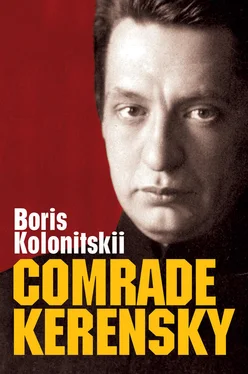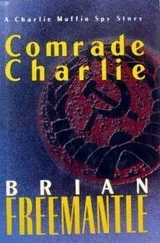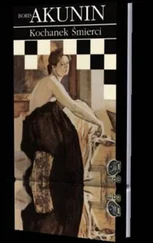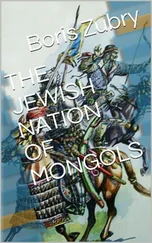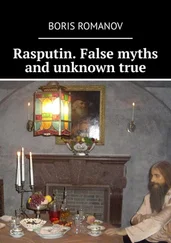‘We are with you. We thank you for coming, and promise to go forward with the people.’
The crowd raised Kerensky shoulder-high and tossed him up and down. 168
The report is not wholly accurate, but it is noteworthy that the reporter made Kerensky the main protagonist. Nearly all Kerensky’s biographers write about his speech to the insurgent soldiers, 169and it became a central plank of his claim to be regarded as the Leader of the revolution.
Kerensky urged the rebels to enter the Tauride Palace, replace the old guards and protect the Duma. He gave orders on where to place sentries. The Duma telegraph and entrances to the palace were occupied by soldiers. The invasion of the palace by an armed crowd changed the deputies’ mood, strengthening the position of the left wing and demoralizing the conservatively minded. The new atmosphere was something of which Kerensky was better placed to take advantage than others. These were bold and dangerous acts: by placing himself at the head of mutinous soldiers he was openly declaring himself the leader of an armed uprising. From the point of view of law-abiding subjects of the tsar, he was a rebel, but by his decisive actions he acquired, in the eyes of the insurgents, the status of a revolutionary leader. In particular, his authority with the soldiers was greatly enhanced. In March an influential journalist was entirely justified in calling Kerensky ‘one of the most prominent leaders of the mutinous army’. 170
Kerensky himself subsequently made use of the episode. ‘I led the first contingent of revolutionary troops into the Tauride Palace and set up a token guard,’ he told a meeting of the soldiers’ section of the Petrograd Soviet on 26 March, when his actions were criticized by leaders of the Soviet. 171This line of argument enabled Kerensky to maintain his standing with the main body of deputies. The entry of troops into the building of the State Duma was one of the most important moments in the history of the February Revolution. In 1917 there were differing accounts of what exactly happened, but all the authors agreed that Kerensky had played a major role, which they often exaggerated. For example, a Nizhny Novgorod newspaper wrote:
A company of some regiment or other with an officer happened to be passing the Tauride Palace…. Suddenly Kerensky appears in the driveway and shouts, ‘Soldiers, the State Duma is with you!’
With a fiery speech he gains the support of the company and its officer, and a minute later Kerensky utters in the parliamentary chamber the call everyone has so desperately been waiting for in those hours of indecision: ‘Members of the State Duma, the soldiers are with us! Here they are!’
A moment later Kerensky delegated a squad of soldiers to arrest Minister Shcheglovitov and bring him to the Tauride Palace, and a moment after that the Volhynia Regiment knew what it had to do and where it needed to go.
That was the beginning of everything.
Whether it is fact or legend, there is good reason why this formula of a fusion of the democratic ‘idea’ (the Duma) with the democratic ‘matter’ (the soldiers) was arrived at by Kerensky. It is the formula which resolved the whole ‘problem’ of the revolution. 172
According to other accounts, Kerensky was entirely ready to win the army over to the revolution. His Odessan biographer writes: ‘Twenty-five thousand armed soldiers were marching towards the Tauride Palace. To what end? Was it in order, at the command of the tsar, to raze to the ground this hotbed of sedition? Or was it to bring tidings of the liberation of the people and emancipation of the army? It seemed there was no one to give an answer. It was approaching, with the tramp of soldiers’ boots and of horse-drawn artillery.’ It was at this critical moment, when, according to the author, ‘chilling doubt’ assailed the deputies’ hearts, that ‘a thin little man, as pale as death and without a hat in the bitter cold’, leaped forth to greet the troops. The revolution was about to win. ‘That little lawyer from Saratov had no way of knowing what he would face on the porch: a red flag or the bayonets of tsarist soldiers. With heroic self-sacrifice he detonated the revolution, and to this day bears that heavy cross.’ 173This factually inaccurate version of events is of interest because Kerensky is presented as the saviour of the revolution, heading off a planned punitive campaign.
Kerensky’s leading of the mutinous soldiers into the Duma was exploited by his supporters also to back his claim to the post of minister of war in May 1917. ‘Kerensky was the first to take command of the revolutionary army when its regiments arrived at the Tauride Palace.’ 174
For many contemporaries, this was the act which accorded Kerensky the status of Leader of the revolution. An address from the sailors on the Baltic cruiser Rossiya , adopted after the April Crisis 175but before 5 May 1917, read:
Did anyone see even a single burzhui [bourgeois] on the revolutionary streets? The whole lot of them, Milyukov, Guchkov, except Comrade Kerensky, all hid themselves away. When, arising, the revolutionary people came to the Tauride Palace and asked to be given a leader, only Comrade Kerensky agreed to be it and lead them who were asking for bread and freedom, but all the rest of the ministers of the present Provisional Government could do was take their portfolios in their hands stained with the blood of our brothers, champions of freedom. 176
It tells us something about those times that this text, composed by grassroots activists, was sent to Soldatskaya pravda and that this newspaper of the Military Organization of the Bolsheviks published it, even though by that time Bolshevik propaganda was already attacking Kerensky, the new minister of war. Even to some Bolshevik supporters Kerensky was still a hero of the revolution, whom they contrasted with the ‘bourgeois’ ministers.
On 27–8 February Kerensky several times made speeches to soldiers. His biographers have latched on to these events to sculpt an image of him as the leader of an armed uprising. ‘When revolutionary regiments began appearing at the State Duma, it was invariably Kerensky who met them. His speeches were brief and powerful and kept up the morale of the revolutionary troops, guiding them towards the only path which could lead them to freedom.’ 177
In those days there were, of course, other Duma deputies delivering speeches to the rebels, but we note that it is Kerensky whom his biographers depict as the Leader with the gift of defining the truly correct path to freedom.
Shortly after the troops entered the Tauride Palace, Kerensky addressed a crowd gathered in the Catherine Hall. His audience was demanding that the leaders of the old regime should be punished. It was the struggle with the internal enemy they saw as the most urgent task. Kerensky called for arrests but demanded that there should be no extrajudicial executions. The crowd wanted names and was thirsting for immediate action. Kerensky ordered that the hated ‘public enemy’ Ivan Shcheglovitov, formerly the minister of justice and later chairman of the State Council, should be brought to him. 178It is interesting that the chairman of the upper chamber rather than any representative of the executive branch was named as the first candidate for arrest. That choice by their new Leader was approved by his listeners, although, from a tactical point of view, it would have seemed more logical in the struggle for power to capture the leaders of the army and police force. This testifies to the role of snap decisions in how the revolution developed.
At this time Kerensky and his comrades were busy organizing the insurgent forces. Present-day researchers write about the creation of a Kerensky General Headquarters, a body which tried to secure the Duma, to draw troops over to the side of the uprising, to arm the rebels and to occupy strategic institutions. That evening a military commission was created, with Kerensky’s group at its core. The Trudovik leader was himself on the commission, and several of its orders are over his signature. 179
Читать дальше
